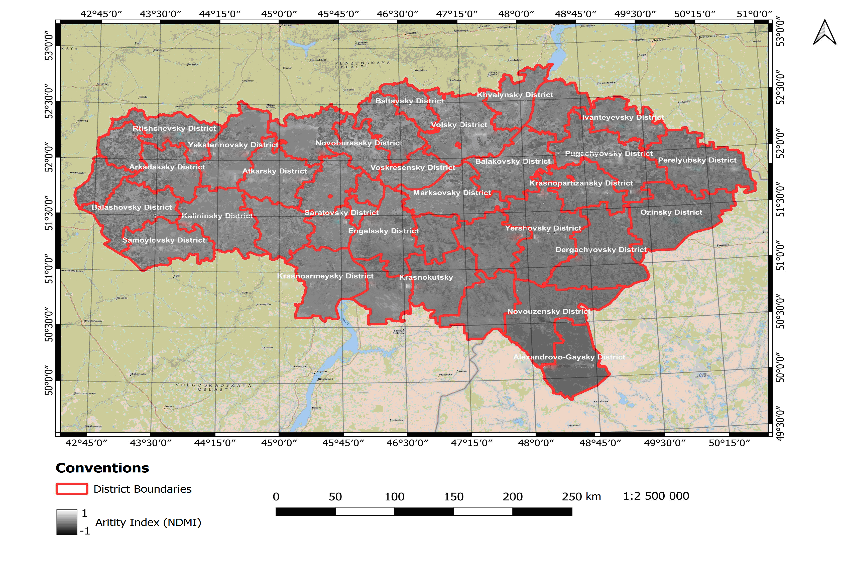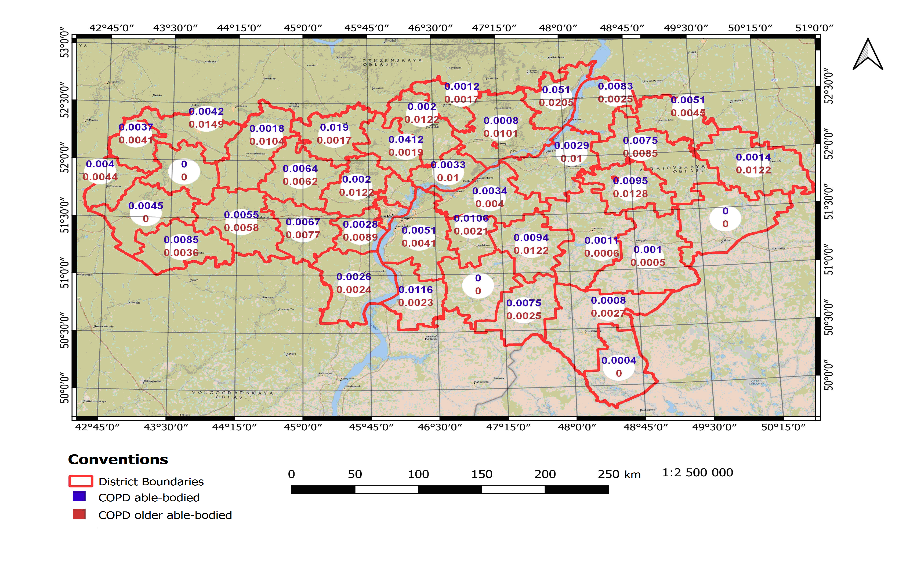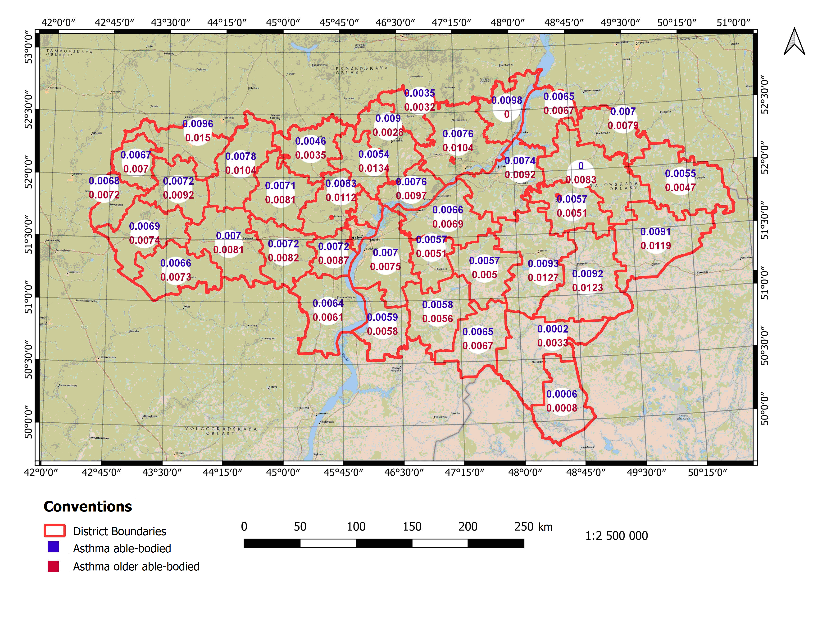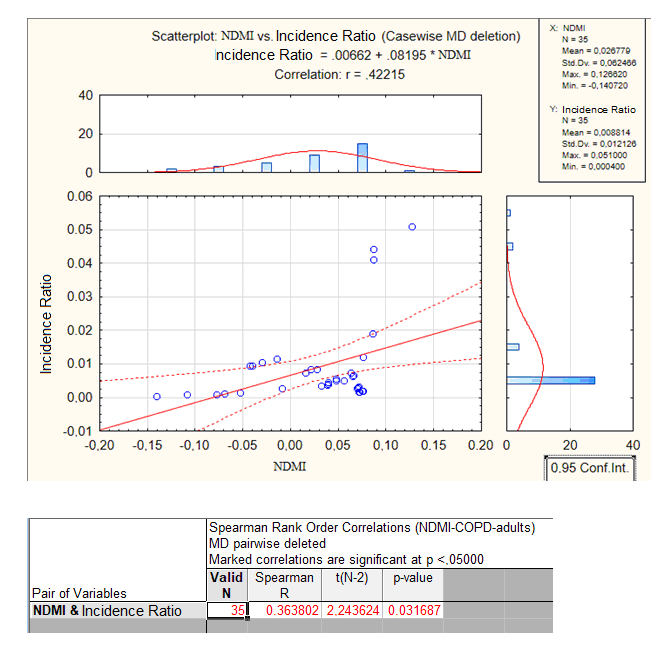Abstract
Currently, there are few data on the contribution of climatic and geographical features, in particular, aridity, to the formation of bronchopulmonary pathology, which is one of the main causes of temporary disability and mortality in the Russian Federation, accompanied by large economic losses. The purpose of the work was to determine the relationship between the degree of aridity of the regions of the Saratov region and the incidence of chronic obstructive pulmonary disease and bronchial asthma in their inhabitants. The object of the study was data on the incidence of bronchopulmonary diseases in the adult population of the Saratov region from the archive of the State Health Institution "Medical Information and Analytical Center" of the Saratov region. The aridity index was determined by deciphering satellite images obtained using the Landsat 8 satellite, image processing and mapping of the studied areas was carried out using the QGIS program. By means of the method of remote sensing of the Earth it was revealed that the aridity index decreases, and the aridity increases when moving from the central to the southern regions of the Saratov region, when moving from the central to the northern and western regions of the region, the aridity index increases, and the aridity decreases. For the first time, a statistically significant correlation was established between the incidence of chronic obstructive pulmonary disease and bronchial asthma among people of working and retirement age living in the Saratov region and the coefficient of dryness.
Keywords: Aridity, bronchial asthma, chronic obstructive pulmonary disease, correlation, earth remote sensing
Introduction
Respiratory diseases are one of the main causes of temporary disability and mortality in the Russian Federation, accompanied by large economic losses. Bronchopulmonary diseases are multifactorial diseases, their formation and the nature of the course are determined by a number of endogenous and exogenous causes, among which the special role of the climatic factor should be noted (Veremchuk et al., 2018a). A correlation has been established between the climatic and geographical region of residence and the formation of chronic nonspecific lung diseases (Gambaryan et al., 2015), in particular, bronchial asthma (Manocha et al., 2021), as well as the severity of its course. It has been found that asthma attacks are more likely to occur in wet, windy and cold weather (Kуrbacheva & Isakova, 2015). The features of the course of bronchial asthma in residents of the northern regions are frequent exacerbations, unstable course, early formation of respiratory failure (Il'ina et al., 2010), while in mountainous areas and areas with a hot and dry climate, asthma attacks are less common and have a lower intensity (Kуrbacheva & Isakova, 2015). In a monsoon climate the problem of adequate follow-up of patients with bronchial asthma is particularly acute, since the combination of high relative humidity and low temperatures has both a direct adverse effect on airway resistance and leads to a decrease in the adaptive-compensatory abilities of lung function (Veremchuk et al., 2018b).
Among the various pathologies of the respiratory system, chronic obstructive pulmonary disease (COPD) occupies a leading position (Raikova et al., 2021). It has been noted that prolonged exposure to cold air has an adverse effect on the course of COPD (Odireev et al., 2013). Bronchial asthma is another global respiratory problem, which affects about a third of the world's population (Schweitzer et al., 2018). It has been established that bronchial hyperreactivity caused by exposure to cold air is a significant risk factor for the development of bronchial obstruction in patients with chronic obstructive bronchitis (Kolosov & Kolosov, 2005). However, when performing information retrieval in Scopus, PubMed and E-library systems, we encountered extremely low publication activity on this topic, especially over the past 5 years, and therefore we consider this study to be extremely relevant.
Problem Statement
From the point of view of preventive and clinical medicine the assessment of the impact of climate on the incidence of respiratory diseases is very relevant, but to date the problem has not been fully resolved. The analysis of respiratory diseases and the contribution of individual factors to their formation is successfully implemented using information technologies (Schweitzer et al., 2018), such as machine learning technology (Santamouris et al., 2020), evolutionary algorithms method (Chekhovych et al., 2018), neural network method (Dwivedi, 2018), digital platform technologies and web portals (Fernández et al., 2022), telemedicine (Mosnaim et al., 2021).
Research Questions
The research questions included as follows:
- To determine the most common nosological forms of diseases of the respiratory system registered in people living in the Saratov region based on the results of statistical data.
- To determine the aridity index in the Saratov region.
- To assess the incidence of bronchopulmonary diseases in the regions of the Saratov region.
- To establish a possible correlation between the incidence of bronchopulmonary diseases and the climatic and geographical area of residence.
Purpose of the Study
The purpose of the study is the analysis of the relationship between the incidence of respiratory organs (chronic obstructive pulmonary disease and bronchial asthma) in the adult population of the Saratov region and the coefficient of aridity of the territory.
Research Methods
The object of the study was data on the incidence of respiratory organs in the adult population of the Saratov region for 2014-2020, provided by the State Health Institution "Medical Information and Analytical Center" (MIAC). Indicators characterizing the incidence of chronic bronchopulmonary diseases were selected for analysis. Retirement age includes females aged 55 and over, males aged 60 and over.
The determination of the aridity index (Normalized difference moisture index - NDMI) was carried out on the basis of Earth remote sensing data, by deciphering satellite images taken by the Landsat 8 satellite with a spatial resolution of 30 m and obtained using the earthexplorer.usgs.gov geoinformation catalog. The mapping of the studied territories was carried out using the QGIS program, version 3.12.3. The equation for calculating the aridity index is as follows:
(1)
where NIR is the reflection coefficient in the near infrared region (nearinfrared, 0.845–0.885 µm); SWIR is the reflection coefficient in the near infrared region (shortwaveinfrared, 1.560–1.660 µm). The NDMI coefficient decreases with increasing aridity.
Assessment of the incidence of bronchopulmonary diseases (n) was carried out according to the equation:
(2)
Nc – the number of cases in a certain age group; Npop – population of the area. Величины Nc and Npop received according to the archive of the MIAC of the Saratov region.
Findings
According to the MIAC, in the structure of respiratory diseases in the adult population of the Saratov region in the period from 2014-2020, one of the priority diseases of the respiratory system, characterized by a progressive course, leading to disability and bearing a significant economic burden, is chronic obstructive pulmonary disease (COPD) and bronchial asthma. The number of COPD diseases in the Saratov region in 2020 among people of working age was 13979 people, among people of retirement age - 5941, the number of cases of bronchial asthma - 14443 and 5586 people, respectively.
Figure 1 shows a map of the distribution of the NDMI aridity index over the territory of the Saratov region. It has been established that the aridity of the regions of the Saratov region increases with the transition from the central regions to the eastern, southeastern and southern ones; decreases in the transition from the central to the marginal northern regions. This fact may be related to the pattern of climate aridization.

The number of people with COPD among the working-age population aged 18 and over increases with the transition from the southern to the northern regions of the Saratov region (see Figure 2).

The number of people with bronchial asthma is increasing in the same direction (see Figure 3).

The correlation between the incidence of COPD, bronchial asthma and the NDMI aridity index was evaluated using the Pearson test. At the same time the exit of points outside the area between the straight line and the asymptotes on the histogram of relative frequencies indicated the deviation of the studied distribution from the Gaussian law (see Figure 4).

None of the studied relationships between the incidence of COPD and bronchial asthma among people of working and retirement age met Pearson's criterion for normal distribution. This indicates that the incidence rates, distributed relative to the NDMI aridity index, that are far from their average value, are no less common than those close to it. In view of this, the assessment of correlation relationships between these characteristics was assessed using the Spearman criterion (see Table 1).
At the same time the Spearman correlation coefficient R was evaluated, as well as the Student's coefficient and the value p, which is the probability of the null hypothesis, that is, the assumption of obtaining the current result when the correlation coefficient is equal to zero. For all considered dependencies, the correlations p<pcr and t(N-2)>tcr(N-2) were observed, that is, the values of the characteristics of the correlation relationship are statistically significant and the null hypothesis of the correlation coefficient being equal to zero is rejected.
The highest incidence of COPD and bronchial asthma was registered in low-arid areas of the Saratov region: Volsky, Khvalynsky, Ivanteevsky, Balashovsky.
Conclusion
It has been established that the degree of aridity of the regions of the Saratov region increases with the transition from the central regions to the eastern, southeastern and southern ones; decreases in the transition from the central to the marginal northern regions. This fact may be related to the pattern of climate aridization.
An increase in the incidence of COPD and bronchial asthma in the adult population during the transition from southern to northern regions may be due to the impact of humidity on the development of these diseases. The established dependence is consistent with the results of the study, which revealed a positive correlation between COPD and asthma rates and an increase in air humidity (an increase in the NDMI index) (Dotsenko et al., 2004).
The question of the role of the contribution of the climatic factor in the overall picture of the development of bronchopulmonary diseases, especially COPD, remains debatable. The development of uncontrolled bronchial asthma shows an increased dependence on the action of climatic factors, among which the main one is air humidity (Veremchuk et al., 2018b). Humanity is currently experiencing global climate change with adverse health effects (Ricciardi et al., 2019). Under conditions of climate aridization, on the one hand, there is a tendency to reduce humidity, and on the other hand, an increase in the toxic effect of atmospheric aerosols and smog phenomena. Therefore, the task of assessing the contribution of individual factors to the formation of respiratory diseases is relevant at the present time. In our opinion, the role of environmental factors in the incidence of COPD and bronchial asthma is great in the mountain-hollow relief types of the urban environment, as well as agglomerations connected by highways.
An increase in climate humidity can lead to the adsorption and dissolution of pollutants on particles of atmospheric aerosols and an increase in their inhalation effect on the body. This is due to the action of atmospheric pollutants, such as PM2,5, PM10, NO2, SO2, H2S, etc. Airborne dust particles reduce solar radiation, increase precipitation, which leads to an increase in humidity (Vitkina et al., 2019), contributing to such thus, the development of bronchopulmonary diseases. It is well known that part of the population is exposed to several risk factors at the same time, while taking into account the synergistic effect of their impact requires special studies, and such attempts are currently being made (Khvashevskaya et al., 2019).
It can be concluded:
- It has been established that the degree of aridity of the territory increases when moving from the central to the southern regions of the Saratov region and decreases in the direction from the central to the northern and western regions.
- For the first time a correlation was established between the increase in the NDMI aridity index of the districts of the Saratov region and the incidence of chronic obstructive pulmonary disease and bronchial asthma in the population of working and retirement age living in the Saratov region.
The problem of the contribution of aridity to the formation of respiratory diseases requires further study.
References
Chekhovych, M. G., Poreva, A. S., Timofeyev, V. I., & Henaff, P. (2018). Using of the machine learning methods to identify bronchopulmonary system diseases with the use of lungsounds. Visnyk NTUU KPI Seriia – Radioteknika Radioaparatura obuduvannia, 73, 55-62. DOI:
Dotsenko, E. A., Krest'yaninova, T. Yu., & Bobrova E. P. (2004). Influence of weather-climaticconditions on bronchial asthmacourse (literature review). Health and environmental issues, 2(2), 41-48. https://www.elibrary.ru/item.asp?id=29438994
Dwivedi, A. K. (2018). Artificialneural network model for effective cancer classification using microarray gene expression data. Neural Computing and Applications, 29(12), 1545-1554. DOI:
Fernández, A. R., Fernández, D. R., Iglesias, V. G., & Jorquera D. M. (2022). Analyzing the use of artificialintelligencefor the management of chronicobstructivepulmonarydisease (COPD). International Journal of Medical Informatics, 158, 104640. DOI:
Gambaryan, M. G., Kalinina, A. M., Shal'nova, S. A., Smirnova, M. I., & Deev, A. D. (2015). Investigation of the epidemiological features of chronic respiratory diseases in relation to the region of residence in Russia. Preventive medicin, 18(1), 14-20. DOI:
Il'ina, E. A., Trapeznikova, B. V., Pachganova, E. V., & Uchakaeva M. I. (2010). Evaluation of the effectiveness of the use of the drug montelukast in the treatment of patients with bronchial asthma with severe cold hyperreativity of the bronchi. Science and modernity, 2-1, 213-218. https://www.elibrary.ru/item.asp?id=21041003
Khvashevskaya, G. M., Karpovich, A. I., & Nerobeeva, S. I. (2019). Assessment of risk factors for chronic nonspecific respiratory diseases in young people. Belarusian State Medical University, Minsk, Belarus. http://rep.bsmu.by/handle/BSMU/26384
Kolosov, A. V., & Kolosov, V. P. (2005). Prediction of airway obstruction. Bulletin of physiology and pathology of respiration, 20, 46-48. https://www.elibrary.ru/item.asp?id=9125943
Kуrbacheva, O. M., & Isakova, I. I. (2015). Bronchial asthma and climate. The best regionstons to live in. Asthma and allergy, 1, 9-12. https://www.elibrary.ru/item.asp?id=26204980
Manocha, A., Bhatia, M., & Kumar G. (2021). Dew computing-inspired health-meteorological factor analysis for early prediction of bronchial asthma. Journal of network and computer applications, 179(2). DOI: 10.1016/j.jnca.2021.102995
Mosnaim, G., Safioti, G., Brown, R., DePietro, M., Szefler, S. J., Lang, D. M., Portnoy, J. M., Bukstein, D. A., Bacharier, L. B., & Merchant R. K. (2021). Digital Health Technology in Asthma: A Comprehensive Scoping Review. The Journal of Allergy and Clinical Immunology: In Practice, 9(6), 2377-2398. DOI:
Odireev, A. N., Kolosov, A. V., Kolosov, V. P., Chzhou, S. D., & Li Ts. (2013). Features of the functioning of mucociliary clearance in patients with chronic obstructive pulmonary disease in the summer and winter periods of the year. Bulletin of physiology and pathology of respiration, 50, 44-50. https://www.elibrary.ru/item.asp?id=20917685
Raikova, S. V., Komleva, N. E., Mikerov, A. N., Potapova, M. V., Zav'yalov, A. I., & Potapova A. S. (2021). Chronic obstructive pulmonary disease: an urgent problem of health saving of modern medicine. Kazan Medical Journal, 102(6), 905-915. DOI:
Ricciardi, W., Marcheggiani, S., Puccinelli, C., Carere, M., Sofia, T., Giuliano, F., Dogliotti, E., Mancini, L., Agrimi, U., Alleva, E., Busani, L., De Castro, P., Gaudi, S, Michelozzi, P., Rezza, G., Testai, E., & Vella, S. (2019). Health and Climate Change: science calls for global action. Ann Ist Super Sanita, 55(4), 323-329. DOI:
Santamouris, M., Paolini, R., Haddad, S., Synnefa, A., Garshasbi, S., Hatvani-Kovacs, G., Gobakis, K., Yenneti, K., Vasilakopoulou, K., Feng, J., Gao, K., Papangelis, G., Dandou, A., Methymaki, G., Portalakis, P., & Tombrou, M. (2020). Heat mitigation technologies can improve sustainability in cities. An holistic experimental and numerical impact assessment of urban overheating and related heat mitigation strategies on energy consumption, indoor comfort, vulnerability and heat-related mortality and morbidity in cities. Energy and Buildings, 217, 110002. DOI:
Schweitzer, M. D., Calzadilla, A. S., Salamo, O., Sharifi, A., Kumar, N., Holt, G, Campos, M., & Mirsaeidi M. (2018). Lung health in era of climate change and dust storms. Environmental Research, 163, 36-42. DOI:
Veremchuk, L. V., Mineeva, E. E., Vitkina, T. I., & Gvozdenko, T. A. (2018a). The influence of climate on the function of external respiration of the healthy population of Vladivostok and patients with bronchopulmonary pathology. Hygiene and Sanitation, 97(5), 418-423. DOI:
Veremchuk, L. V., Vitkina, T. I., Mineeva, E. E., Gvozdenko, T. A., Antonyuk, M. V., Sidletskaya, K. A., Golokhvast, K. S., Tsarouhas, K., Rakitskii, V. N., & Tsatsakis A. M. (2018b). Impact evaluation of environmental factors on respiratory function of asthma patients living in urban territory. Environmental Pollution, 235, 489-496. DOI:
Vitkina, T. I., Veremchuk, L. V., Mineeva, E. E., Gvozdenko, T. A., Antonyuk, M. V., Novgorodtseva, T. P., & Grigorieva E. A. (2019). The influence of weather and climate on patients with respiratory diseases in Vladivostok as a global health implication. Journal of Environmental Health Science & Engineering, 17(2), 907-916. DOI:
Copyright information

This work is licensed under a Creative Commons Attribution-NonCommercial-NoDerivatives 4.0 International License.
About this article
Publication Date
29 August 2022
Article Doi
eBook ISBN
978-1-80296-126-3
Publisher
European Publisher
Volume
127
Print ISBN (optional)
-
Edition Number
1st Edition
Pages
1-496
Subjects
Economics, social trends, sustainability, modern society, behavioural sciences, education
Cite this article as:
Kosarev, A. V., Komleva, N. E., Kosheleva, I. S., Raikova, S. V., Dolich, V. N., & Zaikina, I. V. (2022). Association Between The Respiratory Organ’s Morbidity Of Adult Population And Territorial Aridity. In I. Kovalev, & A. Voroshilova (Eds.), Economic and Social Trends for Sustainability of Modern Society (ICEST-III 2022), vol 127. European Proceedings of Social and Behavioural Sciences (pp. 343-350). European Publisher. https://doi.org/10.15405/epsbs.2022.08.39

